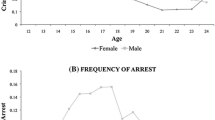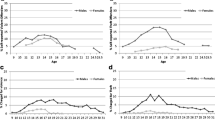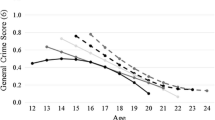Abstract
We use data from a survey covering ages 15–94 to test the Hirschi/Gottfredson hypothesis that the correlates and causes of crime do not interact with age. These data reveal some nonchance interaction between age and demographic and theoretical predictors of criminal behavior that is localized in specific age categories and around particular variables and/or offenses. Overall, however, such interaction does not appear to be substantial, nor does it seem to have important consequences for generalizing from age restricted samples, particularly where generalization is of the most common type-from youth samples to adults. Therefore, despite some results contrary to a strict assertion that the causes and correlates of crime are the same for all ages, our findings support the thrust of the Hirschi/Gottfredson interaction hypothesis.
Similar content being viewed by others
References
Agnew, R. (1985). Social control theory and delinquency: A longitudinal test.Criminology 23: 47–61.
Akers, R. L. (1985).Deviant Behavior: A Social Learning Approach, Third Edition, Wadsworth, Belmont, CA.
Akers, R. L., Massey, J., Clarke, W., and Lauer, R. M. (1983). Are self-reports of adolescent deviance valid? Biochemical measures, randomized response and the bogus pipeline in smoking behavior.Soc. Forces 62: 234–251.
Andenaes, J. (1974).Punishment and Deterrence, University of Michigan Press, Ann Arbor.
Bachman, J. G. (1970).Youth in Transition, Vol II: The Impact of Family Background on Tenth-Grade Boys, Institute for Social Research, University of Michigan, Ann Arbor.
Blumstein, A., Cohen, J., and Farrington, D. P. (1988a). Criminal career research: Its value for criminology.Criminology 26: 1–36.
Blumstein, A., Cohen, J., and Farrington, D. P. (1988b). Longitudinal and criminal career research: Further clarification.Criminology 26: 57–74.
Braithwaite, J. (1989).Crime, Shame and Reintegration, Cambridge University Press, New York.
Chaiken, M. R., and Chaiken, J. M. (1984). Offender types and public policy.Crime Delinq. 30: 195–226.
Clausen, J. A. (1986).The Life Course: A Sociological Perspective, Prentice-Hall, Englewood Cliffs, NJ.
Conklin, J. E. (1981).Criminology, Macmillan, New York.
Curran, D. A. (1984). Characteristics of the elderly shoplifter and the effect of sanctions on recidivism. In Wilbanks, W., and Kim, P. K. H. (eds.),Elderly Criminals, University Press of America, pp. 123–135.
Dannefer, D. (1984). Adolescent development and social theory: A reappraisal.Am. Sociol. Rev. 49: 100–116.
Elliott, D. S., and Ageton, S. S. (1980). Reconciling race and class differences in self-reported and official estimates of delinquency.Am. Sociol. Rev. 45: 95–110.
Farrington, D. P., and Hawkins, J. D. (1991). Predicting participation, early onset, and later persistence in officially recorded offending,Crim. Behav. Ment. Health 1: 1–33.
Fishbein, M. (1967). Attitude and the prediction of behavior. In Fishbein, M. (ed.),Readings in Attitude Theory and Measurement, Wiley, New York.
Fishbein, M., and Ajzen, I. (1975).Belief, Attitude, Intention and Behavior: An Introduction to Theory and Research, Addison-Wesley, Reading, MA.
Gartner, R., and Piliavin, I. (1988). The aging offender and the aged offender. In Baltes, P. B., Featherman, D. L., and Lerner, R. M. (eds.),Life-Span Development and Behavior, Vol. 9, Lawrence Erlbaum Associates, Hillsdale, NJ, pp. 287–315.
Gibbs, J. P. (1975).Crime, Punishment, and Deterrence, Elsevier, New York.
Gibbs, J. P. (1981).Norms, Deviance, and Social Control: Conceptual Matters, Elsevier, New York.
Gottfredson, M., and Hirschi, T. (1986). The true value of lambda would appear to be zero: An essay on career criminals, criminal careers, selective incapacitation, cohort studies, and related topics.Criminology 24: 213–234.
Gottfredson, M., and Hirschi, T. (1988). Science, public policy, and the career paradigm.Criminology 26: 37–55.
Gottfredson, M., and Hirschi, T. (1990).A General Theory of Crime, Stanford University Press, Stanford, CA.
Gove, W. R. (1985). The effect of age and gender on deviant behavior: A biopsychosocial perspective. In Rossi, A. S. (ed.),Gender and the Life Course, Aldine, Chicago, pp. 115–144.
Green, D. E. (1989). Measures of illegal behavior in individual-level deterrence research.J. Res. Crime Delinq. 26: 253–275.
Greenberg, D. F. (1985). Age, crime, and social explanation.Am. J. Social. 91: 1–21.
Greenberg, D. F. (1981). Delinquency and the age structure of society. In Greenberg, D. F. (ed.),Crime and Capitalism, Mayfield, Palo Alto, CA, pp. 118–139.
Hagan, J., and Palloni, A. (1988). Crimes as social events in the life course: Reconceiving a criminological controversy.Criminology 26: 87–100.
Hanushek, E. A., and Jackson, J. E. (1977).Statistical Methods for Social Scientists, Academic Press, New York.
Hindelang, M. J., Hirschi, T., and Weis, J. (1981).Measuring Delinquency, Sage, Beverly Hills, CA.
Hirschi, T. (1969).The Causes of Delinquency, University of California Press, Berkeley, CA.
Hirschi, T., and Gottfredson, M. (1983). Age and the explanation of crime.Am. J. Sociol. 89: 552–584.
Kercher, K. (1987). Explaining the relationship between age and crime: The biological vs sociological model. Presented at the annual meeting of the American Society of Criminology; Montreal.
LaGrange, R. L., and White, H. R. (1985). Age differences in delinquency: A test of Theory.Criminology 23: 19–45.
Liska, A. E. (1987).Perspectives on Deviance, Second Edition, Prentice-Hall, Englewood Cliffs, NJ.
Loeber, R., and LeBlanc, M. (1990). Toward a developmental criminology. In Tonry, M., and Morris, N. (eds.),Crime and Justice: A Review of Research, Vol. 12, University of Chicago Press, Chicago, pp. 375–473.
Loeber, R., and Snyder, H. N. (1990). Rates of offending in juvenile careers: Findings of constancy and change in lambda.Criminology 28: 97–109.
Meier, R. F., and Johnson, W. T. (1977). Deterrence as social control: The legal and extralegal production of conformity.Am. Sociol. Rev. 42: 292–304.
Merton, R. K. (1957). Social structure and anomie. In Merton, R. K. (ed.),Social Theory and Social Structure, Free Press, New York, pp. 131–194.
Murray, G. F., and Erickson, P. G. (1987). Longitudinal research: An empirical comparison of projected and subsequent criminality.Soc. Sci. Res. 16: 107–118.
Nagin, D. S., and Farrington, D. P. (1992). The stability of criminal potential from childhood to adulthood.Criminology 30: 235–260.
Nagin, D., and Paternoster, R. (1991). On the relationship of past to future delinquency.Criminology 29: 163–189.
Newman, E. S., Newman, D. J., Gewirtz, M. L.,et al. (1984).Elderly Criminals, Oelgeschlager, Gunn, and Hain, Cambridge, MA.
Orcutt, J. D. (1987). Differential association and marijuana use: A closer look at Sutherland (with a little help from Becker).Criminology 25: 341–358.
Osgood, D. W., Johnston, L. D., O'Malley, P. M., and Bachman, J. G. (1988). The generality of deviance.Am. Sociol. Rev. 53: 81–93.
Paternoster, R., and Triplett, R. (1988). Disaggregating self-reported delinquency and its implications for theory.Criminology 26: 591–625.
Petee, T. A. (1989).Delineating Individual and Aggregate Level Effects in Deviance: A Contextual Approach, Ph.D. dissertation, University of Notre Dame, Notre Dame, IN.
Petersilia, J. (1978). The validity of criminality data derived from personal interviews. In Wellford, C. (ed.),Quantitative Studies in Criminology, Sage, Beverly Hills, CA, pp. 30–47.
Riley, M. W., Foner, A., and Waring, J. (1988). Sociology and age. In Smelser, N. (ed.),Handbook of Sociology, Sage, Newbury Park, CA, pp. 243–290.
Rowe, A. R., and Tittle, C. R. (1977). Life cycle changes and criminal propensity.Sociol. Q. 18: 223–236.
Rowe, D. C., Osgood, D. W., and Nicewander, W. A. (1990). A latent trait approach to unifying criminal careers.Criminology 28: 237–270.
Sampson, R. J., and Laub, J. H. (1990). Crime and deviance over the life course: The salience of adult social bonds.Am. Sociol. Rev. 55: 602–627.
Schlegel, R. R., Crawford, C. A., and Sanford, M. D. (1977). Correspondence and mediational properties of the Fishbein model: An application to adolescent alcohol use.J. Exp. Soc. Psychol. 13: 421–430.
Shavit, Y., and Rattner, A. (1988). Age, crime, and the early life course.Am. J. Sociol. 93: 1457–1470.
Shover, N. (1985).Aging Criminals, Sage, Beverly Hills, CA.
Shover, N., and Thompson, C. Y. (1992). Age, differential expectations, and crime desistance.Criminology 30: 89–104.
Smith, D. A., and Visher, C. A. (1980). Sex and involvement in deviance/crime: A quantitative review of the empirical literature.Am. Sociol. Rev. 45: 691–701.
Smith, D. A., Visher, C. A., and Jarjoura, G. R. (1991). Dimensions of delinquency: Explaining the correlates of participation, frequency, and persistence of delinquent behavior.J. Res. Crime Delinq. 28: 6–32.
Steffensmeier, D. J. (1983). Organization properties and sex-segregation in the underworld: Building a sociological theory of sex differences in crime.Soc. Forces 61: 1010–1032.
Steffensmeier, D. J., Streifel, C., and Harer, M. D. (1987). Relative cohort size and youth crime in the United States, 1953–1984.Am. Sociol. Rev. 52: 702–710.
Steffensmeier, D. J., Allan, E. A., Harer, M. D., and Streifel, C. (1989). Age and the distribution of crime.Am. J. Sociol. 94: 803–831.
Sutherland, E. H. (1939).Principles of Criminology, 3rd ed., Lippincott, Philadelphia.
Tillman, R. (1987). The size of the “criminal population”: The prevalence and incidence of adult arrest.Criminology 25: 561–579.
Tittle, C. R. (1980).Sanctions and Social Deviance: The Question of Deterrence, Praeger, New York.
Tittle, C. R. (1988). Two empirical regularities (maybe) in search of an explanation.Criminology 26: 75–85.
Tittle, C. R., and Villemez, W. J. (1977). Social class and criminality.Soc. Forces 56: 474–502.
Tittle, C. R., Burke, M. J., and Jackson, E. F. (1986). Modeling Sutherland's theory of differential association: Toward an empirical clarification.Soc. Forces 65: 405–432.
Tonry, M., Ohlin, L. E., and Farrington, D. P. (1991).Human Development and Criminal Behavior, Springer-Verlag, New York.
Vinokur-Kaplan, D. (1978). To have or not to have another child: Family planning attitudes, intentions, and behaviors.J. Appl. Soc. Psychol. 8: 29–46.
Wellford, C. F. (1973). Age composition and the increase in recorded crime.Criminology 11: 61–70.
Wilbanks, W. (1984). The elderly offender: Sex and race variations in frequency and pattern. In Wilbanks, W., and Kim, P. K. H. (eds.),Elderly Criminals, University Press of America, pp. 41–52.
Wilbanks, W., and Kim, P. K. H. (eds.) (1984).Elderly Criminals, University Press of America.
Williams, K. R., and Hawkins, R. (1986). Perceptual research on general deterrence: A critical review.Law Soc. Rev. 20: 545–572.
Wolfgang, M., Thornberry, T. P., and Figlio, R. M. (1987).From Boy to Man, from Delinquency to Crime, University of Chicago Press, Chicago.
Zimring, F. E., and Hawkins, G. J. (1973).Deterrence: The Legal Threat in Crime Control, University of Chicago Press, Chicago.
Author information
Authors and Affiliations
Rights and permissions
About this article
Cite this article
Tittle, C.R., Ward, D.A. The interaction of age with the correlates and causes of crime. J Quant Criminol 9, 3–53 (1993). https://doi.org/10.1007/BF01064236
Issue Date:
DOI: https://doi.org/10.1007/BF01064236




